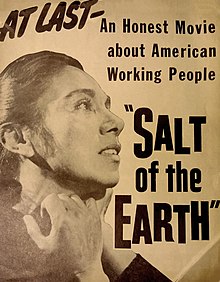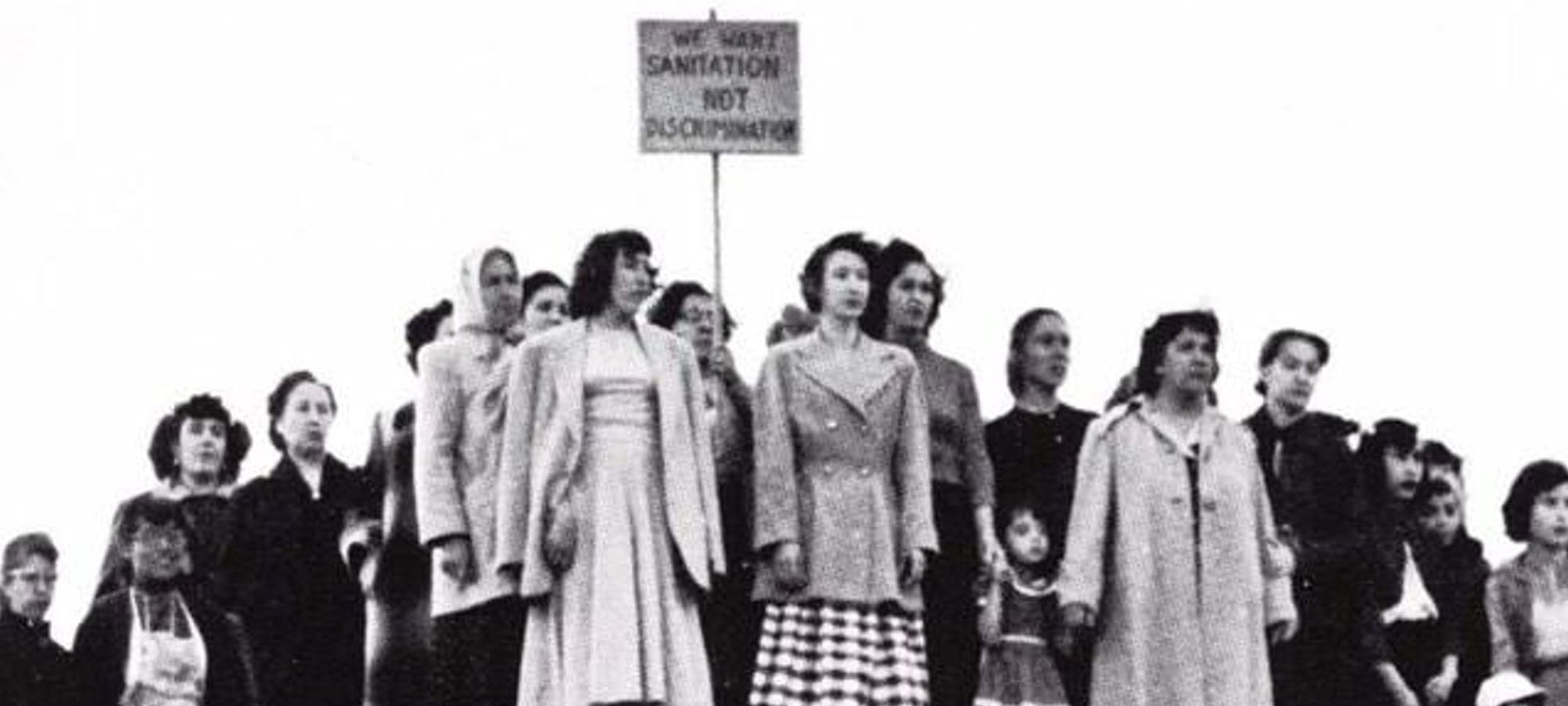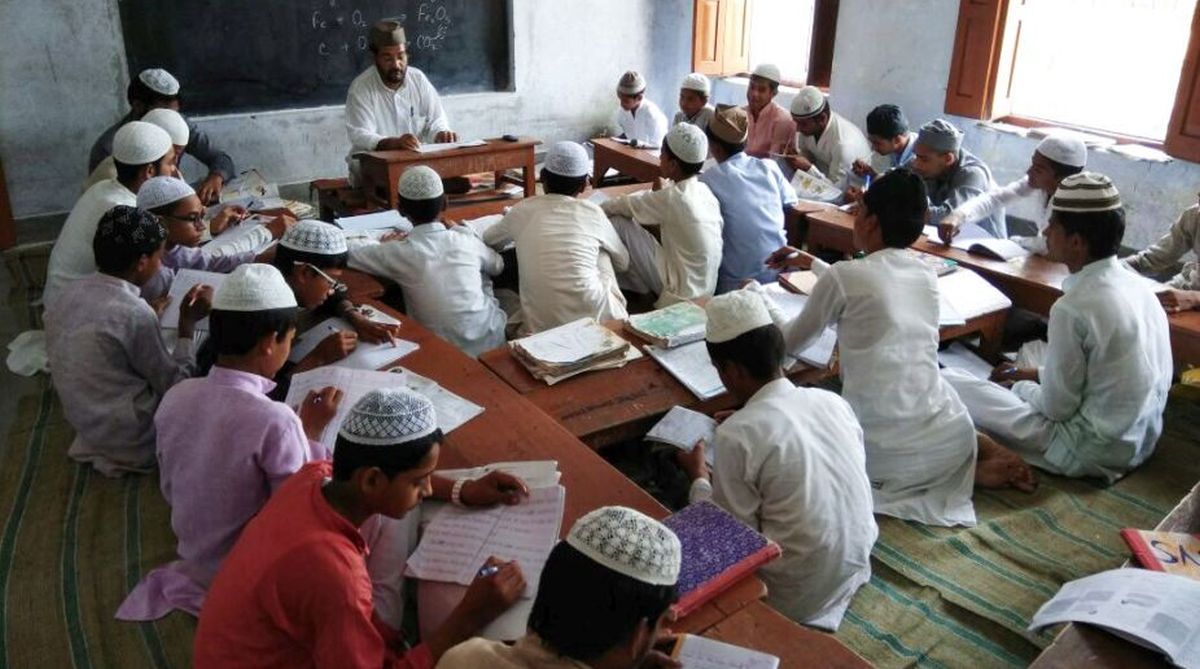When Salt of the Earth (1954) was filmed, the people involved in its creation did not know that it would one day be touted as one of Hollywood’s classics. Indeed, when the movie was first released (prevailing over the United States government’s multiple attempts at repressing its production), it was immediately blacklisted. Let’s not forget the film’s director, Herbert Biberman, was part of the (in)famous Hollywood Ten.
Nevertheless, Salt of the Earth was and remains a masterpiece in cinematic history not only because of what it depicts but also because of how it depicts it. The film is at its core, a docudrama about the 15-month long Empire Zinc Strike organised by miners of Mexican heritage in the small hamlet of Hanover in New Mexico. This strike against the Empire Zinc Company’s unjust and discriminatory policies started in October 1950 and ended on 24 January, 1952. Yesterday marked the 70th year of the strike.
The film begins with a voiceover of the protagonist and narrator, Esperanza Quintero, a Mexican woman and the wife of one of the key leaders of the strike, later to become a key part of the strike herself, against the backdrop of fields and houses from the town the movie is set in. She says, “How shall I begin my story that has no beginning? In these several years, my great grandfather raised cattle before the Anglos ever came. Our roots go deep in this place, deeper than the pines, deeper than the mine shafts. This is my village. When I was a child, it was called San Marcos, the Anglos changed the name to Zinc Town. Zinc Town, New Mexico, U.S.A. This is our home.”
The fact a woman narrates the story of this strike not only foregrounds the importance of the role women played in the strike, but it also gives them agency to talk about the issues that plagued them. These creative choices become all the more significant as women in Mexico were given the right to vote only in 1953 – a year before the movie was released.
It was then that the women suggested that since they were not miners nor part of the Union, the Act could not be imposed upon them and therefore they should take over the picket line, so as to keep the strike from crumbling. This was followed by much deliberation and discussion among the men, who voted to adjourn the present Union meeting and convert it into a community meeting in order to allow all the present women to vote and voice their views on the issue. A decision was reached and though it was a close call, the majority voted in favour of this idea
Salt of the Earth highlights an array of issues Esperanza’s community faced, some of which include issues of gender, settler colonialism, race, and class among others. This article, however, seeks to focus on the significant role of women and women’s solidarity in the miners’ strike.
Although the Empire Zinc Strike cannot truly be called a feminist struggle, at least as far as semantics go, that does not, however, change the fact that it was a watershed moment in the chequered history of women’s solidarity movements in the West. When the strike began in 1950, the key demands of the workers’ union (The International Union of Mine, Mill, and Smelter Workers) were that the Company end its discriminatory pay policies and provide the same facilities which were of avail to the Anglo miners in other towns under the jurisdiction of the company.

The women of the community, who dredged in their houses, did the domestic work that was traditionally expected of them, demanded that the Union add issues of indoor plumbing and hot water in the list of their demands, for these women had to walk long distances to collect water for all household chores and then heat the water up to make it good for use. However, these demands were dismissed by the men who said those were issues of comparatively little importance and could be discussed later.
As the strike went on, with the miners’ seemingly unbreakable picket line, eight months passed before the Taft-Hartley Act (The Labor Management Relations Act of 1947, better known as the Taft–Hartley Act, is a United States federal law that restricts the activities and power of labor unions) was finally evoked by the company. This posed problems for the miners as it left them with all but two choices: either abide by the Act and stop picketing – which would result in the loss of the strike, or continue the strike and get arrested – which, too, would mark the end of the movement.
It was then that the women suggested that since they were not miners nor part of the Union, the Act could not be imposed upon them and therefore they should take over the picket line, so as to keep the strike from crumbling. This was followed by much deliberation and discussion among the men, who voted to adjourn the present Union meeting and convert it into a community meeting in order to allow all the present women to vote and voice their views on the issue. A decision was reached and though it was a close call, the majority voted in favour of this idea.
As the events in the film unfold, we see how the women stand their ground, despite the police’s attempts at breaking their picket line. In a profound scene, the men – the husbands, fathers, sons, and brothers of these women are shown watching them uphold the strike. These men hold their children in their arms. As the women protest peacefully and spend entire days and nights on the picket line, the innumerable household responsibilities fall on the shoulders of men
Salt of the Earth shows how the women took over the picket line, and protested against the life threatening environment in which the miners worked, as well as the lack of basic necessities in their households. They were undeterred in spite of the many conniving attempts from the police and the Company: including the use of tear gas, an attempt to run over the women in the picket line with their cars, arresting them with baseless accusations, stopping all supplies of groceries and other essentials to the town’s only general store, and finally attempting to evict Esperanza’s family from their home.
Also read: Brick Kiln Labourers: Women Are Underpaid And Lack Decisive Power Or Status

As the events in the film unfold, we see how the women stand their ground, despite the police’s attempts at breaking their picket line. In a profound scene, the men – the husbands, fathers, sons, and brothers of these women are shown watching them uphold the strike. These men hold their children in their arms. As the women protest peacefully and spend entire days and nights on the picket line, the innumerable household responsibilities fall on the shoulders of men.
This interesting reversal of gender roles brings the attention of the men to the issues of indoor plumbing and hot water as now it is them who have to walk miles to collect wood and water for chores like laundry, cooking, washing, etc. Naturally, it so happens that the Union decides that these issues were indeed grave and to be prioritised in the proposed list of their demands.
Salt of the Earth, therefore, is a concise account of the solidarity among women not just in Zinc Town but across the United States, and even the world, who pitched in across the time period of 15 months to help them. This spirit of community, sorority, and an engagement with agency and power led the women to successfully complete the strike and have the Company agree to all their demands
When the women are arrested by the police, they are thrown in a single jail cell. Esperanza is stuck in there with her baby, who subsequently grows hungry and starts crying. The women then begin chanting slogans for the officers to open the jail cell or to bring the child’s formula to them so that she can be fed. The chanting of the slogans together creates a ruckus in the police station and eventually the formula is brought and the women are let go, for a lack of a charge against them.
They return to the picket line the next day, and so, the strike persists. Unions across the United States hear of the determination of the women and when the company stops supply of food and groceries to the town’s general store, women from across the fifty states send in packaged food and other necessities for the families in Zinc Town. This poignant act deems this strike all the more important in the history of women’s solidary movements because it involves not just the women directly affected by the Company’s policies but also those living far off.

The icing on the cake, so to say, is that almost all the characters in the film were played by the actual strikers and protesters. One exception was that of the character of Esperanza – inspired by the strike organizer Juan Chacon’s wife, Claudia Chacon – played by the eminent Mexican actor Rosaura Revueltas – who, during the course of the filming, was deported to Mexico in an attempt by the government to put an end to the production of the film.
Salt of the Earth, therefore, is a concise account of the solidarity among women not just in Zinc Town but across the United States, and even the world, who pitched in across the time period of 15 months to help them. This spirit of community, sorority, and an engagement with agency and power led the women to successfully complete the strike and have the Company agree to all their demands.
This event occurred a good decade or so before the Second Wave of feminism picked up pace in the West and started talking of the sociopolitical advantages and the power of women’s solidarity and commune. The Empire Zinc Strike, was therefore, not just a fight for the rights of Mexican miners – an excellent example of Union organisation and peaceful protests, but also an event which marked a shift in the consciousness of men and women.
For the former became more empathetic towards the condition of women, while the latter recognised the power they hold not just individually but in togetherness, on a political front.
Also read: Strikers in Saris: The Grunwick Dispute | #IndianWomenInHistory
Pratishtha is pursuing Master’s in English from University of Delhi. Aside from reading and writing, she enjoys painting, playing the piano, and petting cats. She may be found on Instagram
Featured Image Source: Vincent Price Art Museum




